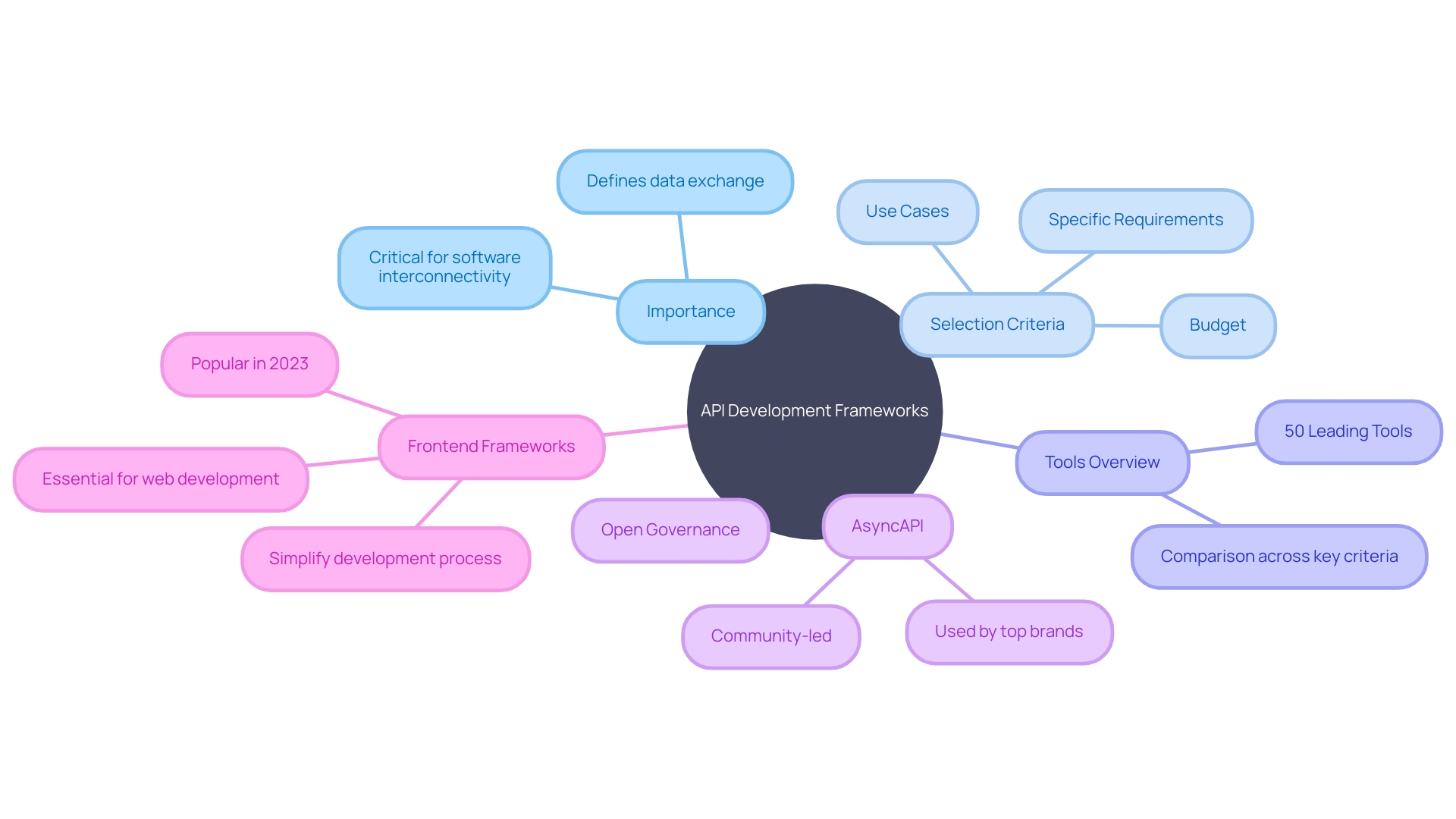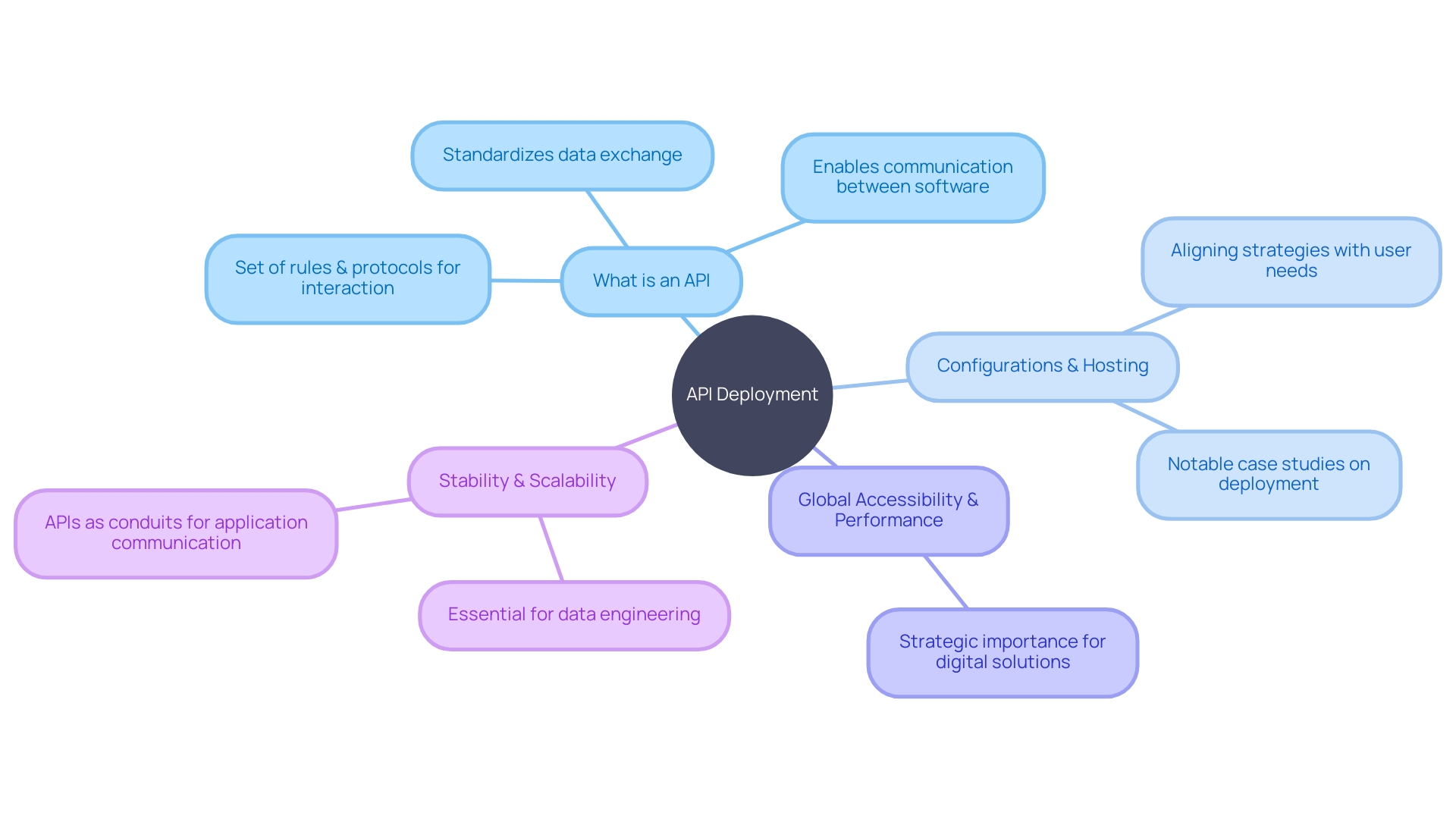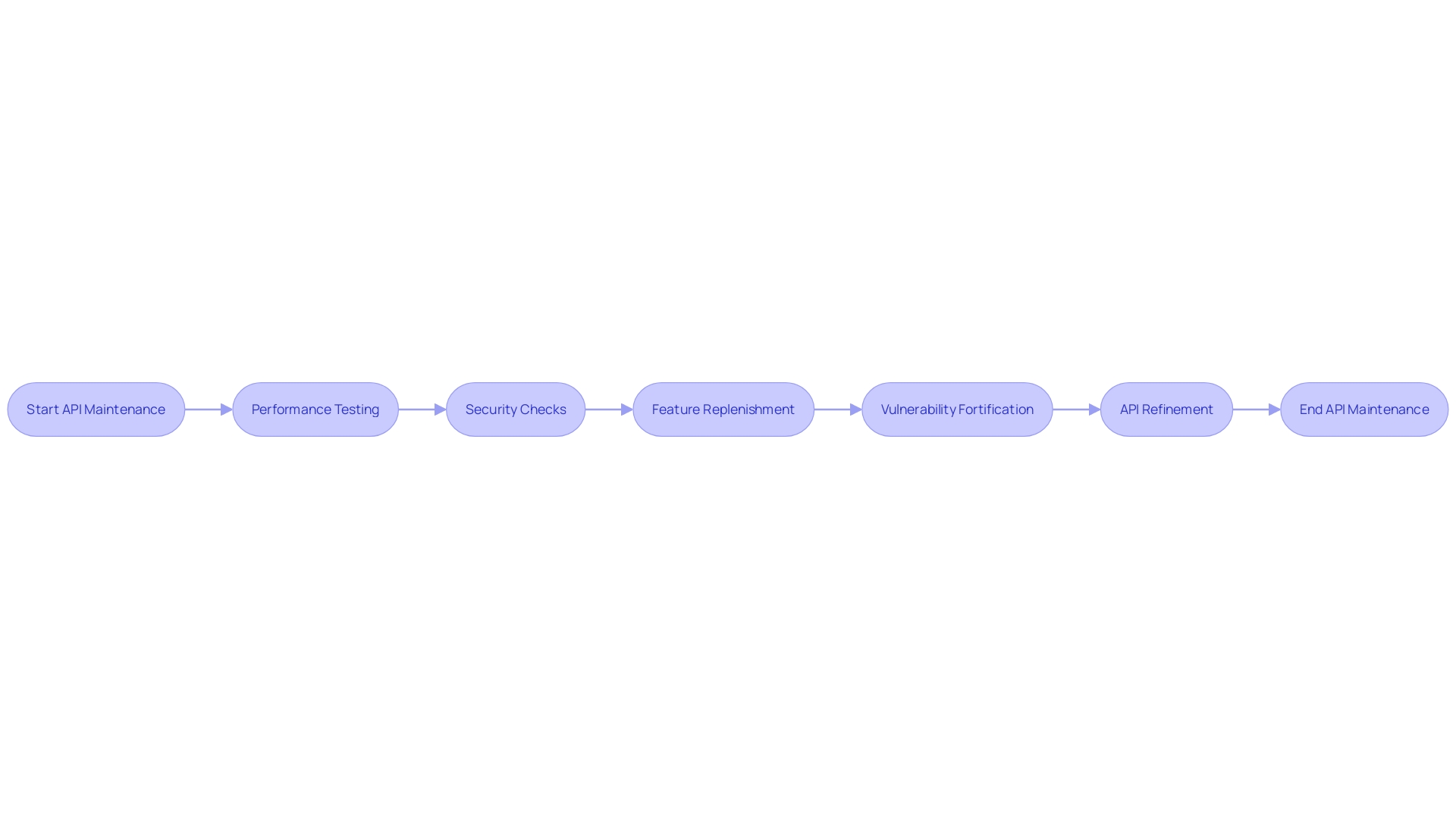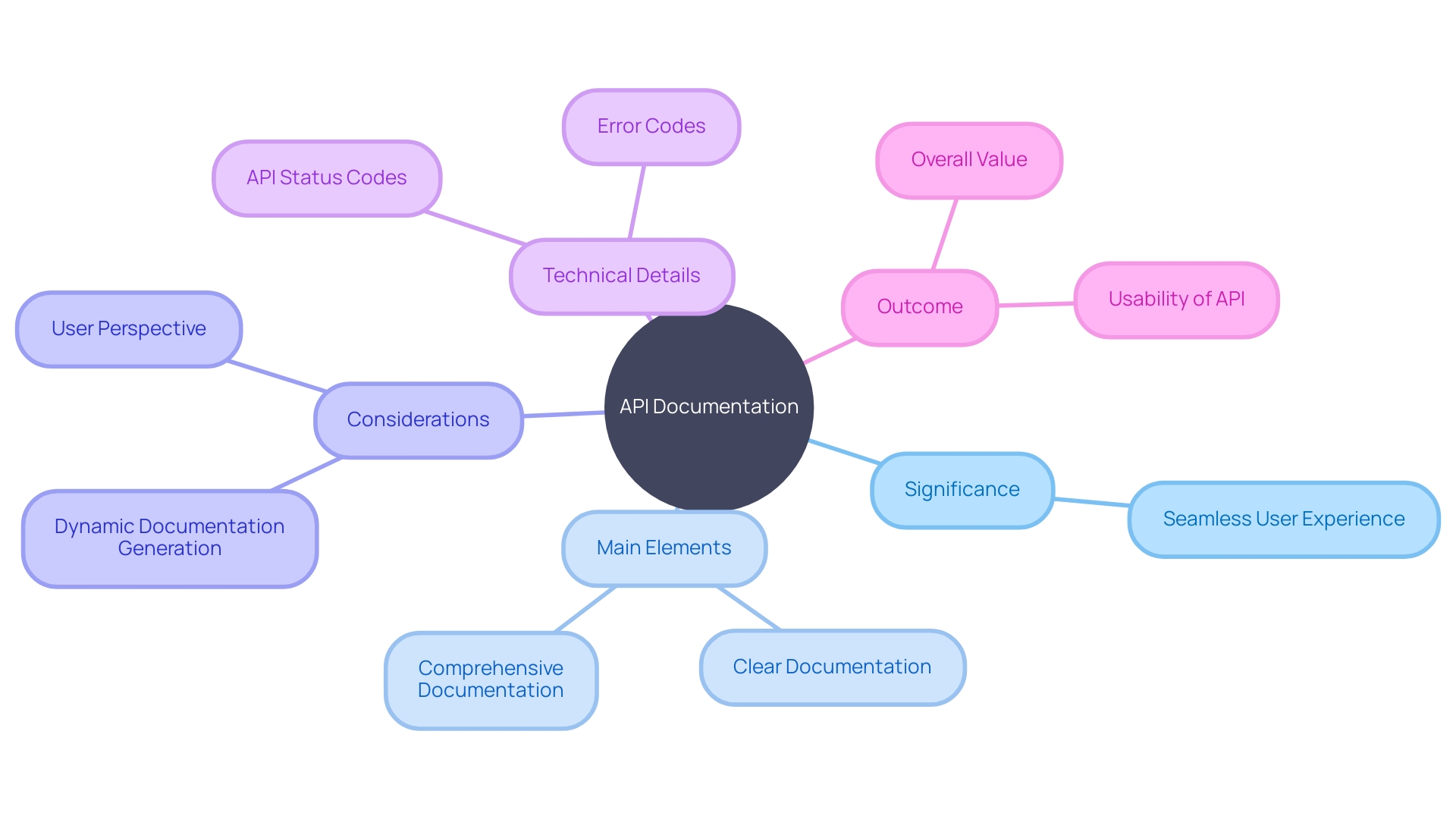Introduction
Application Programming Interfaces (APIs) are the driving force behind modern software architectures, enabling seamless integration and empowering developers to build complex applications. Adopting an API-first approach from the start is key to achieving efficiency and productivity. In this article, we explore the essential steps to develop an API groundwork that champions adoptability and smooth integration.
From defining API requirements to securing and maintaining the API, we delve into each phase, emphasizing the benefits of a well-designed and documented API. By following these steps, you can create robust APIs that cater to the diverse needs of today's digital realm.
Why Create an API
Application Programming Interfaces (APIs) serve as the foundation of modern software architectures, allowing disparate systems to interact and empowering developers to build more complex, feature-rich applications. These key components facilitate the seamless integration of third-party services, enhancing both the efficiency and capability of software projects. The growing trend of API-first development has shifted the focus towards prioritizing API design at the inception of a project, acknowledging its critical role in software's structural integrity and future-proofing.
The API-first approach begins with articulating the API contract—a meticulous plan that lays out the endpoints, the expected requests and responses, and precise data models. This foresight is instrumental in fostering widespread adoption, providing a developer-friendly environment for integration and ensuring compatibility across a multitude of platforms. APIs are not only seen as the diplomatic channels, enabling applications, which we can liken to independent kingdoms, to exchange valuable data but also as the technical threads that intricately weave the various components of a software ecosystem into a cohesive unit.
Evidence of the importance of APIs in the tech industry is reflected by Google's description of APIs as the "crown jewel of software development." This analogy underscores the transformative impact APIs have when they perfectly orchestrate the flow of data between systems—akin to a vibrant city center where distinct neighborhoods work together harmoniously due to a shared, unified communication channel.
In this exploration, we aim to demystify API-first development and guide you through the pivotal steps of constructing an API groundwork that champions adoptability, developer appeal, and smooth integration. By adopting an API-centric mindset from the start, you can anticipate a diverse range of user needs—building not just a singular solution, but a versatile platform that serves multiple stakeholders and catalyzes innovation. Let's venture into the essentials of API design, where technical finesse meets the practical needs of modern, data-driven software solutions.
Prerequisites for Building an API
Embarking on API development necessitates a blend of technical knowledge and strategic preparation. A solid grip on programming concepts combined with proficiency in a language, such as Python, sets the foundation for successful development. Python has been espoused by industry professionals due to its clarity and efficiency in projects ranging from simple microservices to complex financial platforms.
Delving into API craftsmanship, one must recognize the API-first development philosophy—a modern strategy that ensures APIs form the cornerstone of your project. Adopting an API-first mindset not only streamlines the development process but also amplifies the adoption and integration capabilities of your software, as delineated by software development experts.
For instance, let's paint a practical scenario: consider the steps required to integrate a payment system into a travel agency website, where understanding web development principles becomes indispensable. Leveraging frameworks like Python Flask and front-end technologies such as React.js, you can construct a system exemplified by Rapyd's Collect API—an efficient solution crafted to manage multi-country transactions.
Before the first line of code is written, it's imperative to establish your developer environment, equipped with the requisite tools that resonate with an efficient and results-driven approach. A Rapyd Client Portal account, for example, is an essential gateway for accessing the Collect API. This principle of preparedness is accentuated in tech circles and expertly summarized by innovators like J. Vester, who champion the strategic use of time to focus on extending the value of one's technical endeavors.
Furthermore, an API-first development methodology dictates defining the API contract upfront—a process emphasizing the definition of endpoints and request-response structures, as highlighted by professionals deeply rooted in software architecture. It's a concerted effort aimed at ensuring the API's quality, consistency, and reusability.
As you make headway, remember that community interaction and sharing knowledge can fine-tune your development process. Engaging with peers on developer forums offers a wealth of insights and may even inspire contributions that further the collective intellectual progress.
In summary, initiating the journey of API development envelops a multitude of aspects - from selecting the right programming language and embracing the API-first approach to engaging with the developer community and setting up a conducive development environment. Grasping these essentials is key to building robust APIs that cater to the interconnectivity needs of today’s digital realm.
Step 1: Define API Requirements
Establishing solid API requirements is more than simply a preparatory step; it's the foundation on which the structure of seamless interaction is built. Consider an API to be a bridge, allowing applications to exchange data. The essential task is to determine what traffic will flow over this bridge - in other words, understanding the specific functionality it will provide and the data it will ferry across.
Documentation isn't just busy work; it's a blueprint outlining the architecture of data exchange. Take, for instance, the case of Infobip API, which meticulously includes links to clarify concepts that might perplex beginners, ensuring that each term is a building block rather than a barrier. Furthermore, addressing your API's communication effectively through status and error codes transforms them into an insightful layer of documentation that remains current and informative.
Combining these elements with a compassionate approach to writing paves the way for APIs that are not only functional but also accessible, scaling the heights of user-friendliness while anchored in technical rigor.

Step 2: Choose an API Framework
Selecting an API framework is a pivotal decision that shapes the future of your software development and integration success. These frameworks not only offer pre-built tools, libraries, and conventions to streamline development but also provide support for fundamental API tasks such as routing, security protocols, and error management. With the emergence of languages like Python, notable for its advancements with the release of Python 3.12, frameworks like Flask have gained popularity.
Flask's minimalistic yet extensible approach enables the rapid development of simple to complex applications. A trivial Flask app requires minimal code to set up a basic route, showcasing its ease of use.
When it comes to JavaScript with Node.js, Express.js offers a lightweight layer built on Node.js, empowering developers to build efficient APIs with an array of HTTP utility methods at their disposal. For Ruby enthusiasts, Ruby on Rails stands out as a full-stack web application framework that prides itself on its convention over configuration philosophy, facilitating rapid development.
Choosing the right framework extends beyond the programming language; it embraces the ecosystem, considering factors such as third-party integrations and community support. A well-supported framework like Django boasts robust security features and scalability, handling the demanding digital ecosystems of large enterprises like TotalEnergies Digital Factory. Meanwhile, businesses like Chick-fil-A encounter the need for explicit, well-documented API contracts to resolve communication barriers, emphasizing the significance of framework selection for API clarity.
With the budding API landscape, the importance of thorough documentation and frameworks' compatibility with trending technologies cannot be understated. As APIs drive modernization and help avoid operational silos - with 93% of organizations acknowledging their critical role, according to Vanson Bourne's research - your framework choice becomes the foundation of a modern and connected application architecture.

Step 3: Set Up the Development Environment
Setting up an efficient development environment is often glossed over in tutorials, but it's the crucial first step before diving into API design. First, you'll want to install the programming language and framework of your choice, along with any other dependencies. This sets the groundwork for creating your own APIs, which are essential intermediaries allowing applications to swap data and functionalities smoothly.
Using an IDE like Visual Studio Code, you can jump into action. Take a moment to revel in the creative process of naming your project—since it's no secret that this is where developers spend a decent chunk of their time. Once that's settled, and with plugins like Yeoman and the VS Code Extension Generator installed, you’re good to go.
These tools scaffold out your project, giving you a structured head start.
Remember, it's all about creating that isolated development bubble using a virtual environment, so your work remains unaffected by other projects. This level of isolation is akin to what Docker does with its containers. They're like shipping containers for your code, transportable across systems without a hitch, keeping your development neat and your deployments consistent.
As you embark on this journey of setting up, recall Docker's playful whale logo—a nod to the core concept behind their product. In a world of continuous updates and the ever-evolving ecosystem of NodeJS and other technologies, maintaining this kind of scalable and isolated development space is not just practical but necessary for modern software innovation.
Step 4: Design API Endpoints
Designing API endpoints is more than defining routes; it’s about creating a highly efficient avenue for software interactions. These endpoints are the touchpoints where various applications can request and exchange information within your API's interface, governed by a specific set of methods and paths. By harnessing methodologies like RESTful principles, you ensure that your API is user-friendly and makes sense to client developers who expect certain conventions.
For instance, reflecting on the domain of 'Accounts' illustrates the complexity of API design. Different departments may perceive 'Accounts' with starkly different lenses. For example, from a Departmental Perspective, Sales/Marketing may view an account as a prospective customer with leads and revenue predictions, while Finance may consider it in terms of billing.
Such intricacies highlight the significance of designing intuitive and role-specific API endpoints that cater to varied interpretations and use cases.
As we embrace modern practices and tools for API development and establish standards like REST, it’s crucial to acknowledge the evolution of software interactions. The maturation of SaaS and the subsequent need for reliable, communicative APIs have underlined the importance of meticulous API design.
Remember, each API endpoint you create is an opportunity to facilitate a seamless transaction of data and services between diverse software components. As such, delving deep into your domain and prioritizing the functionalities that are most relevant will allow you to construct a solid and future-proof structure for your API's endpoints.
Step 5: Implement API Endpoints
Creating effective API endpoints is more than just about the code—it is about understanding the need behind each interaction and ensuring that every request and response is catered to enhance the functionality and performance of the system. This phase is critical as developers are not just writing code, but they are also embedding the business logic that defines how your API behaves and interacts with different systems. For a moment, let's consider harnessing the capabilities of pre-trained models like Hugging Face for sentiment analysis of reviews.
Traditionally, developing such a model from the ground up would be a substantial effort. But with API development, once the model is ready, creating an endpoint allows users within an organization to leverage this powerful tool instantly, without having to build it themselves, illustrating the power of APIs in modern development environments.
When defining and handling API endpoints using your framework of choice, whether it involves functions, classes, or decorators, think about the stories shared by veterans in the field. Like the experiences at large financial institutions where focusing on user needs—rather than wants—led to more impactful results. Envision Henry Ford's customers who, unaware of cars, called for faster horses; when what they needed was a more rapid means of transportation.
Translating this to API design, anticipate the underlying needs your API fulfills, and construct endpoints that address these efficiently and effectively.
In line with the principles of REST, ensuring that each API request contains all the required information to be fully understood and processed has become a standard. This statelessness means your endpoints must be designed to perform their duties independently of the persistent state of client engagements.
Moreover, consider SmartBear, serving over 32,000 organizations, including giants like Adobe and JetBlue, a testament to the significance of APIs as pillars in modern software infrastructure. The narratives support the vastly collaborative nature of APIs and affirm their critical role in connecting various aspects of an organization’s operations. Follow the leadership of industry experts who treat APIs not just as tools, but as the 'crown jewels' of development, essential for innovation and the evolution of technology.
In summary, the iterative process of implementing API endpoints is an art that balances technical expertise with a deep understanding of the needs it aims to fulfill. It's about building a bridge for applications to converse and thrive in a data-enriched ecosystem.
Step 6: Test the API
In the dynamic realm of software development, the significance of Application Programming Interfaces (APIs) is unquestionable, not only for the enhancement of digital convenience and efficiency but also for the maintenance of a strong cybersecurity posture. As more systems integrate and communicate through APIs, the necessity to conduct regular API testing gains prominence. This rigorous process entails a meticulous evaluation to authenticate the functionality, performance, and security of APIs.
Testing intervals, known as testing cycles, can be tailored to suit different operational environments, reinforcing the need for versatile frameworks and tools. With a rise in automated testing, which encompasses unit, integration, correctness, and load testing, developers have the advantage of conducting comprehensive assessments without manual intervention.
Unit testing scrutinizes the smallest, independent code units and is integral to both prior and subsequent development phases. Furthermore, Test-Driven Development (TDD) strategies advocate for test formulation before actual code is even written, setting a structured pathway for development.
Nevertheless, it is crucial to distinguish between the utilization of the terms automated, unit, and TDD, as each plays a distinct role in the testing ecosystem. Insights from technical experts suggest that certain patterns are vital across all forms of testing, advocating for simplicity, focusing on valuable tests, and refraining from delving into specific implementation details.
Recent data unveils the alarming rate of API-related security incidents, with 78% of cybersecurity teams encountering such breaches over the past year. While a considerable number of organizations maintain a complete API inventory, astonishingly, only 40% can monitor APIs that handle sensitive data. Consequently, API security has soared as a priority for 81% of these teams, signaling an industry-wide shift towards more robust security measures.
In essence, automated testing frameworks and tools are not merely accessories but necessities in the intricate process of API testing—setting the stage for an extensive series of articles focused on leveraging popular tools like Cypress and Rest Assured to heighten API robustness. Upcoming discussions will emphasize core principles, anchoring our understanding of Web APIs as gateways that orchestrate user interface and server interactions. Employing these frameworks offers the potential to preempt and rectify issues, ensuring that APIs are not only functional but fortified against cyber threats.
Step 7: Deploy the API
When your API has passed rigorous testing, the next crucial step is the deployment stage. This critical phase introduces your API to its users, enabling interactions and functionalities that fulfill your users' needs. You have a spectrum of options for deployment, from cloud services to containers like Docker, each offering its unique advantages in scalability and resource management.
The objective is to ensure a seamless experience where the API remains responsive and efficient under varying loads. This isn't just about making your project live; it's about fulfilling the core promise of accessibility and utility.
Deployment isn't merely a checkbox in the development workflow; it's a comprehensive process that encapsulates several aspects:
- Configuration and Hosting: Selecting a platform that best suits the API’s needs and configuring it appropriately.
- Global Accessibility & Performance: Ensuring smooth function across diverse regions, considering the user base’s geographic spread.
- Stability and Scalability: Anticipating user demand and scaling resources up or down as required.
With deployment, you translate months of development into real-world value. It's not just an operational step but a strategic one—streamlining efficiency and maximizing the impact of your application. Whether your API serves internal purposes or it's meant for a broader audience, deployment determines how well it integrates into the ecosystem and how effectively it solves the problems it is designed for.
Take into account lessons from industry experts who stress the importance of aligning deployment strategies with user needs, rather than mere wants, to tailor your API to deliver real, tangible benefits.
Contemplate the profound implications of these processes by studying notable case studies like Aave’s handling of $2 billion worth of liquidated positions, emphasizing the importance of robust and thoughtful deployment strategies to safeguard and enhance the value offered to users. Deployment transcends beyond making the API merely available; it shapes the experience, impacts efficiency, and, ultimately, the success of your digital solutions.

Step 8: Secure the API
To defend against the increasing threat of unauthorized data access through APIs, it is essential to integrate robust security protocols within your digital infrastructure. Authentication, authorization, and encryption stand as the pillars of API security, serving as mechanisms to verify user identities, set user permissions, and protect data as it moves across networks. Methods such as API keys, OAuth protocols, and JSON Web Tokens (JWT) are parts of a broader strategic defense, tailored to address specific security needs and minimize the risk of breaches.
Alarmingly, the statistics indicate that 78% of cybersecurity teams have encountered an API-related incident in the past year, underscoring the urgency of this issue. With the backdrop of an astonishing number of recent breaches, including a high-profile incident involving Eicher Motors and Toyota Tsusho Insurance Broker India (TTIBI), the imperative of securing APIs cannot be overstated. In that particular breach, an email account became a gateway to the broader corporate infrastructure, leading to potentially catastrophic data exposure.
This event illustrates the domino effect of a single vulnerability.
Organizations are being urged to reevaluate their API security strategies in response to these threats. A comprehensive inventory of APIs, alongside understanding their usage, architecture, and associated data, enables businesses to establish a 'gold standard' for API security, informed by the nature of their operations and regulatory obligations. As industry experts have highlighted, it is crucial to map out how APIs fit within business units and functions, understanding the 'data in motion' related to these APIs, and implement appropriate security mechanisms such as authentication types and rate-limiting.
APIs are integral to the modern digital landscape, being deployed across critical sectors. However, their prolific use tags them as high-value targets for malicious actors. Hence, reinforcing API security is no longer a best practice but a necessity, weaving into the very fabric of responsible and resilient software development.
Step 9: Document the API
Ensuring an API is meticulously documented plays a pivotal role in its adoption and usability by developers. To facilitate this, one must delineate clear and precise guidelines on engaging with each API endpoint, articulating the expected formats for requests and responses. Tools like Swagger or OpenAPI can automate and hence streamline this endeavor, generating documentation from the code itself.
Such automation can mitigate issues like document-code desynchronization and keep documentation from becoming outdated—an all too common issue with manually written documentation. Additionally, robust documentation not just simplifies the developer's integration process but also serves as the initial touchpoint for users encountering your API, providing a narrative that clearly conveys the API's benefits and functionalities.
Foremost, a comprehensive product overview is indispensable; it should succinctly communicate the essence of the API and the specific market need it addresses. In a market saturated with APIs, differentiation hinges on the clarity of this message. Furthermore, akin to a user manual that outlines the operation of a laptop, API documentation equips the user with the knowledge to employ the API effectively, thus enhancing the developer experience and potentially leading to better outcomes, such as heightened customer satisfaction and increased productivity—reflective of the views of 97% of organizations according to Vanson Bourne's research.
In the dynamic arena of API development, documented APIs have a distinct advantage. Not only do they ensure coherence and readability but also guide users in making the most of the API with a clear understanding. Documentation integrity is vital, as reflected in Spotify's Backstage platform challenges, where manual data ingestion and fixed data models can result in inefficiencies.
Embracing a user-centric approach, where the personae of different user cohorts are taken into account, can dramatically improve the onboarding process, allowing new users to harness the benefits of an API promptly and effectively.
Step 10: Monitor and Maintain the API
Maintaining an API extends far beyond its initial launch, and this ongoing process is crucial for ensuring the interface's functionality, performance, and reliability. Engaging in a cycle of consistent API testing, examining aspects like performance and security, allows developers to preemptively tackle challenges that could disrupt the service. It's about anticipating needs rather than reacting to wants.
It's a lesson from industry leaders who advocate for a needs-driven approach, emphasizing the value of regular, proactive maintenance over a reactive stance. True to the responsibility of upkeep, the practice of performance and stress tests, combined with steady updates and security checks, forms the bedrock of a robust API management strategy. Reflecting the industry's shift towards placing APIs at the forefront of organizational functionality, statistics from Vanson Bourne's 'The State of APIs, Integration, and Microservices' research underscore the critical role they play, with 93% confirming APIs' relevance to organizational operation.
The right testing intervals, guided by real-world demands and technological advances, ensure APIs meet user expectations efficiently, mirroring the uninterrupted, reliable service provided by leading digital services and spanning across industries. Therefore, regular replenishment of features, fortification against vulnerabilities, and refinement of API endpoints and functions are more than just maintenance—they are an unspoken promise of excellence to users who rely on seamless digital experiences.

References
When considering the significance of API documentation, think of it as the user manual for a device - but instead of physical knobs and buttons, APIs link software in a language that may be complex. Good documentation makes these interactions comprehensible and straightforward, like a well-detailed guide accompanying a sophisticated gadget. It's essential just as the manual is for understanding a laptop's features.
Envision manually-written documentation as a static snapshot, akin to a printed page in a notebook. While it may provide a description of the API at a moment in time, it's prone to become outdated as the API evolves, sometimes even feeling uninspired in its approach.
Instead, dynamic documentation generated directly from the API's controllers can ensure that any updates in the code are immediately reflected in the documentation, maintaining its relevance and effectiveness. This 'code-first' approach, often implemented through domain-specific languages (DSLs), effectively keeps the documentation in sync with the API and engages the developer in an on-going conversation about the tool's capabilities. As mentioned in the Infobip API reference, it is crucial to consider the user's perspective, especially beginners.
Including links to further explanations or embedding tooltips ensures that no user is left behind due to unfamiliar terminology.
API documentation should not only be clear and intuitive but also comprehensive. It should cover endpoints, methods, parameters, and expected responses. Organize content methodically, starting from basic concepts and building upon that knowledge.
It's beneficial to break down documentation into digestible sections, making it easier for users to pinpoint the information they need without wading through dense paragraphs.
What's more, communication through API status and error codes is vital. Treated as a form of documentation, these messages offer direct insight into the API's operation and should be as current and informative as possible. According to industry experts, thorough and up-to-date documentation is a statement of quality, echoing Peter Drucker's sentiment that quality is measured by the value it provides to the customer.
PyPI's security audit, generously backed by the Open Technology Fund, underlines the commitment to quality and the importance of reliable and secure documentation. Documentation, then, is more than just a manual; it is a crucial component that directly impacts the quality and usability of an API, facilitating developers' tasks and ultimately ensuring a seamless user experience for the end-users of the applications built upon these APIs.

Conclusion
In conclusion, an API-first approach is essential for efficient and productive software development. By defining API requirements, choosing the right framework, setting up a development environment, and designing and implementing endpoints, developers can create robust and user-friendly APIs.
Thorough testing, secure deployment, meticulous documentation, and proactive monitoring and maintenance are crucial for the success of APIs. They ensure functionality, performance, reliability, and security over time.
With Kodezi, developers have access to the tools and resources needed to streamline API development and achieve maximum efficiency and productivity. By leveraging Kodezi's platform, developers can focus on building innovative and well-documented APIs that meet the diverse needs of the digital realm.
APIs play a vital role in enabling seamless integration and enhancing software applications' capabilities. By prioritizing API design and following best practices, developers can create APIs that not only function effectively but also improve user-friendliness and scalability.
With Kodezi as a partner, developers can embark on their API development journey with confidence, knowing they have the support and tools required to create exceptional APIs. By embracing an API-first approach and utilizing Kodezi's capabilities, developers can drive innovation, empower modern software architectures, and deliver tangible benefits to users.
In today's interconnected world, APIs are key to unlocking the full potential of software applications. By embracing an efficient and results-driven approach with Kodezi, developers can create APIs that cater to the diverse needs of the digital realm, ensuring seamless integration and maximizing efficiency and productivity.
Frequently Asked Questions
What are APIs and why are they important?
APIs (Application Programming Interfaces) are essential for modern software architectures, enabling different systems to interact and allowing developers to create complex applications. They facilitate the integration of third-party services, enhancing the efficiency and capabilities of software projects.
What is API-first development?
API-first development is a strategy that prioritizes API design at the inception of a project. It involves creating a detailed API contract that outlines endpoints, expected requests and responses, and data models to ensure compatibility and ease of adoption.
What prerequisites are needed for building an API?
To embark on API development, one should have a solid understanding of programming concepts and proficiency in a programming language, such as Python. Familiarity with web development principles and tools like Python Flask and React.js is also beneficial.
What are the key steps in building an API?
The key steps include: 1. Define API Requirements 2. Choose an API Framework 3. Set Up the Development Environment 4. Design API Endpoints 5. Implement API Endpoints 6. Test the API 7. Deploy the API 8. Secure the API 9. Document the API 10. Monitor and Maintain the API.
How do I define API requirements?
Defining API requirements involves understanding the specific functionalities the API will provide and the data it will handle. Proper documentation serves as a blueprint for data exchange and enhances user-friendliness.
What should I consider when choosing an API framework?
When selecting an API framework, consider the programming language, ecosystem, third-party integrations, community support, and the framework's capabilities for routing, security, and error management.
How do I set up a development environment for API development?
The development environment should include the necessary programming language and framework installations, as well as tools like Visual Studio Code. Using a virtual environment is recommended for isolating projects.
What are API endpoints and how should they be designed?
API endpoints are the touchpoints for software interactions. They should be designed using methodologies like RESTful principles to ensure they are user-friendly and cater to specific functionalities relevant to different departments.
Why is testing important in API development?
Testing is crucial for verifying the functionality, performance, and security of APIs. Regular testing helps identify and rectify potential issues, ensuring the API remains reliable and efficient.
What deployment options are available for APIs?
APIs can be deployed through various platforms, including cloud services and containers like Docker. The goal is to ensure global accessibility, stability, and scalability to meet user demands.
What security measures should be implemented for APIs?
Robust security protocols, including authentication, authorization, and encryption, are essential for API security. Methods like API keys, OAuth, and JSON Web Tokens (JWT) should be utilized to protect data and prevent unauthorized access.
How important is API documentation?
Comprehensive API documentation is vital for usability and adoption by developers. It should clearly outline guidelines for engaging with endpoints, expected formats for requests and responses, and provide a narrative of the API's functionalities.
What does monitoring and maintaining an API involve?
Monitoring and maintaining an API involves regular testing for performance and security, updating features, and refining endpoints. This ongoing process ensures the API continues to meet user needs and remains resilient against potential issues.




